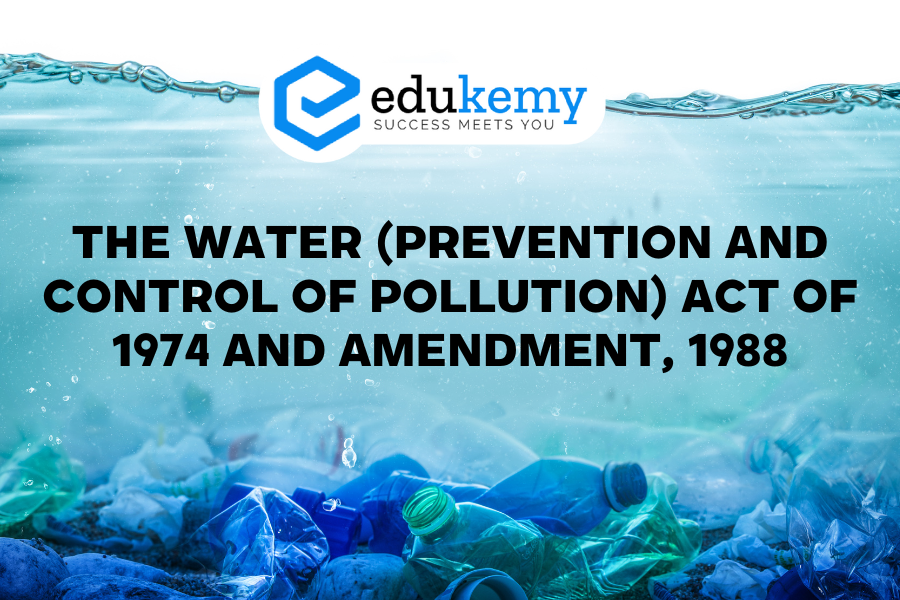- The enactment of the Water (Prevention and Control of Pollution) Act in 1974 aimed at preventing and controlling water pollution, along with the restoration of water wholesomeness throughout the country.
- Notably, this Act underwent an amendment in 1988.
- In 1977, the Water (Prevention and Control of Pollution) Cess Act was introduced to authorize the imposition and collection of a cess on water consumption by entities engaged in specific industrial activities.
- State Pollution Control Boards were entrusted with the regulatory authority to establish and enforce effluent standards for factories.
- Similarly, the Central Pollution Control Board took on this responsibility for Union Territories while also formulating policies and coordinating activities among various State Boards.
- Under the Act, both State Pollution Control Boards and the Central Pollution Control Board were granted the authority to examine equipment and collect samples for analytical purposes.
- Before the 1988 amendment, enforcement was primarily carried out through criminal prosecutions initiated by the Boards.
- The amendment in 1988 further empowered both State Pollution Control Boards and the Central Pollution Control Board to shut down non-compliant industrial plants.
Contents
- 1 FAQs: Water Prevention and Control of Pollution Act of 1974 (Amendment) 1988
- 1.1 1. What is the Water (Prevention and Control of Pollution) Act of 1974?
- 1.2 2. What was the objective behind the 1988 amendment to the Act?
- 1.3 3. What significant change did the Water (Prevention and Control of Pollution) Cess Act of 1977 bring about?
- 1.4 4. How does the Cess Act encourage pollution control?
- 1.5 5. What role do State Pollution Control Boards play under the Acts?
- 2 In case you still have your doubts, contact us on 9811333901.
WATER PREVENTION AND CONTROL OF CESS ACT 1977
- The Water (Prevention and Control of Pollution) Cess Act of 1977 was enacted with the primary aim of generating financial resources to support the operational costs of the Central and State Pollution Boards.
- This legislation establishes economic incentives for pollution control by imposing a cess (tax) on water effluent discharge, which is to be paid by local authorities and specific designated industries.
- In the operational framework outlined by the Act, the Central Government, following the deduction of collection expenses, disburses such sums as it deems necessary to the central and state boards.
- Notably, the Act incorporates a mechanism to encourage capital investment in pollution control – a polluter is eligible for a 70% rebate on the applicable cess upon the installation of effluent treatment equipment.
FAQs: Water Prevention and Control of Pollution Act of 1974 (Amendment) 1988
1. What is the Water (Prevention and Control of Pollution) Act of 1974?
A: The Water (Prevention and Control of Pollution) Act of 1974 is legislation in India designed to prevent and control water pollution, focusing on maintaining and restoring the wholesomeness of water across the country.
2. What was the objective behind the 1988 amendment to the Act?
A: The 1988 amendment aimed to enhance the regulatory framework for controlling water pollution. It conferred additional powers to regulatory bodies and introduced mechanisms for stricter enforcement against non-compliant industrial plants.
3. What significant change did the Water (Prevention and Control of Pollution) Cess Act of 1977 bring about?
A: The Cess Act of 1977 introduced a mechanism to generate financial resources for the Central and State Pollution Boards by imposing a cess (tax) on water effluent discharge from specific industrial activities.
4. How does the Cess Act encourage pollution control?
A: The Cess Act creates economic incentives for pollution control by requiring local authorities and designated industries to pay a cess. Furthermore, it provides a 70% rebate on the cess for polluters installing effluent treatment equipment.
5. What role do State Pollution Control Boards play under the Acts?
A: State Pollution Control Boards are vested with regulatory authority to establish and enforce effluent standards for factories. They also have the power to examine equipment, collect samples, and enforce standards within their respective states.
In case you still have your doubts, contact us on 9811333901.
For UPSC Prelims Resources, Click here
For Daily Updates and Study Material:
Join our Telegram Channel – Edukemy for IAS
- 1. Learn through Videos – here
- 2. Be Exam Ready by Practicing Daily MCQs – here
- 3. Daily Newsletter – Get all your Current Affairs Covered – here
- 4. Mains Answer Writing Practice – here

